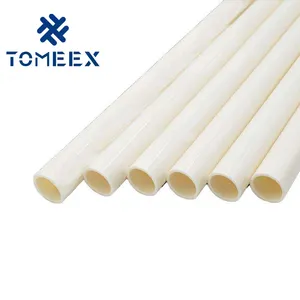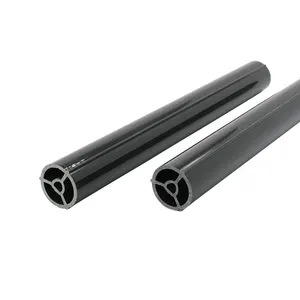
Plastic Fittings Fitting Astm Inch Coated Dwv 4 Schedule 40 Black And Plumbing Diameter Lean Pe Esd Fuel Pool Ring End Abs Pipe



















Choosing the right materials for plumbing can significantly influence the durability, cost-effectiveness, and environmental footprint of a project. Acrylonitrile Butadiene Styrene (ABS) and Polyvinyl Chloride (PVC) are two commonly used materials. This article will delve into why ABS pipes might be the superior choice for your project, exploring their composition, uses, durability, installation ease, and environmental impact.
ABS and PVC are prevalent in plumbing systems. They share some common uses but also have key differences. ABS pipe contains a chemical called bisphenol A, or BPA, which is absent in PVC. This chemical contributes to the durability of ABS pipes. ABS is always black, while PVC is commonly white. ABS connections are made with a special cement, while PVC connections require a two-step process. ABS is stronger and can resist higher shock or impact, while PVC is more flexible and better at muffling the sound of water flow.
ABS and PVC are popular for pipe construction due to their non-toxic and abrasion-resistant properties. ABS is known for its ease of installation, while PVC is often made more flexible with the addition of plasticizers. However, both materials have their limitations. ABS can deform when exposed to sunlight, while PVC is not resistant to aromatic and chlorinated hydrocarbons.
ABS is a black plastic pipe commonly used for drainage, sewage, and vents, often in drain-waste-vent systems. It's durable, resistant to high temperatures, and ideal for both hot and cold water applications. ABS is also resistant to various chemicals, making it suitable for industrial settings. PVC, a white or light-colored plastic pipe, is typically used for plumbing and drainage. It's durable, flexible, and can withstand high temperatures without deforming. PVC is often used for indoor plumbing, while ABS is preferred for outdoor and underground plumbing.
ABS piping is a cost-effective choice for commercial and residential uses. It won’t flake, peel, rot, dissolve, fade, or leak unless punctured. It’s ideal for use outside, underground, in extreme cold, and where it isn’t in direct sunlight. ABS is a bit stronger and can resist higher shock or impact compared to PVC. ABS pipe connections are made with a special cement, making it a one-step process, unlike PVC. It's often the choice of plumbers for use in drain, waste, and vent piping systems, and as electrical insulation.
ABS pipe was the first residential plastic pipe to appear on the market. It is made from a thermoplastic resin and comes in a wide variety of sizes. ABS typically has a 50-year lifespan. One of the main advantages of ABS pipe is that it can be connected with a quick one-step gluing process. The pipe does not work well in hot-temperature applications (more than 160°F), and can deform in the sun. When used outdoors, some local regulations require ABS pipe to be painted with a water-based latex paint or to contain special pigments that prevent ultraviolet (UV) light from penetrating it.
ABS pipes are known for their excellent temperature resistance. They can withstand high operating temperatures, making them ideal for various applications. The maximum operating temperature of ABS pipes depends on the type of material and wall thickness. It's important to note that the working pressure of ABS pipes varies with these factors. Furthermore, ABS pipes exhibit high heat distortion temperature, which is the temperature at which a test piece of the material reaches a specified deflection when placed in a heat medium with a bending load applied. This makes ABS pipes a reliable choice for projects requiring high-temperature resistance.
Installing ABS pipes is relatively straightforward. The ideal solution is to cut the pipe and insert a Tee. You'll have to lift the upper part of the pipe enough to slip in the T junction and then lower the pipe down into the T and glue it. Alternatively, you can drill into the existing pipe with a hole saw, then attach a fitting on it with enough glue to make it stick. However, ensure to secure the pipe to prevent movement during the process. This ease of installation makes ABS pipes a superior choice for your project.
ABS and PVC have distinct environmental impacts. Neither ABS nor PVC is biodegradable, making their disposal a concern. PVC, in particular, poses additional environmental issues. PVC-coated wires can produce harmful HCl (Hydrochloric acid) fumes in a fire, posing a health hazard. Furthermore, plasticizers may leak out of PVC into the environment. The EU has banned three types of phthalates used in PVC: DBP, BBP, and DEHP, due to these concerns.
ABS plastics, including ABS pipes, are recyclable. This includes a variety of products such as sheets, shower trays, car parts, and skeletal waste. Recycled ABS is gaining popularity as raw ABS can be costly in manufacturing. The ABS plastic that can be supplied is segregated according to material origin, ensuring quality. This recycling process not only makes ABS a cost-effective choice but also contributes to a more sustainable environment.
PVC production involves large electricity consumption and releases harmful component molecules, including a potent carcinogen, VCM, and a neurotoxin, EDC. PVC usage requires heavy metal stabilisers and phthalates, posing health risks. PVC disposal is problematic as it is rarely recycled, often downcycled into lower-grade plastic products. Incineration of PVC produces hazardous waste and releases dioxin.
In conclusion, ABS pipes offer a compelling alternative to PVC in many respects. Their strength, durability, and ease of installation make them a cost-effective choice for both commercial and residential uses. ABS pipes are also superior in terms of environmental impact, as they are recyclable and do not release harmful substances like PVC. However, it's important to consider the specific requirements of your project, as ABS pipes have limitations, such as deformation under sunlight and high temperatures. Nevertheless, for projects requiring high-temperature resistance, durability, and a straightforward installation process, ABS pipes are a superior choice.